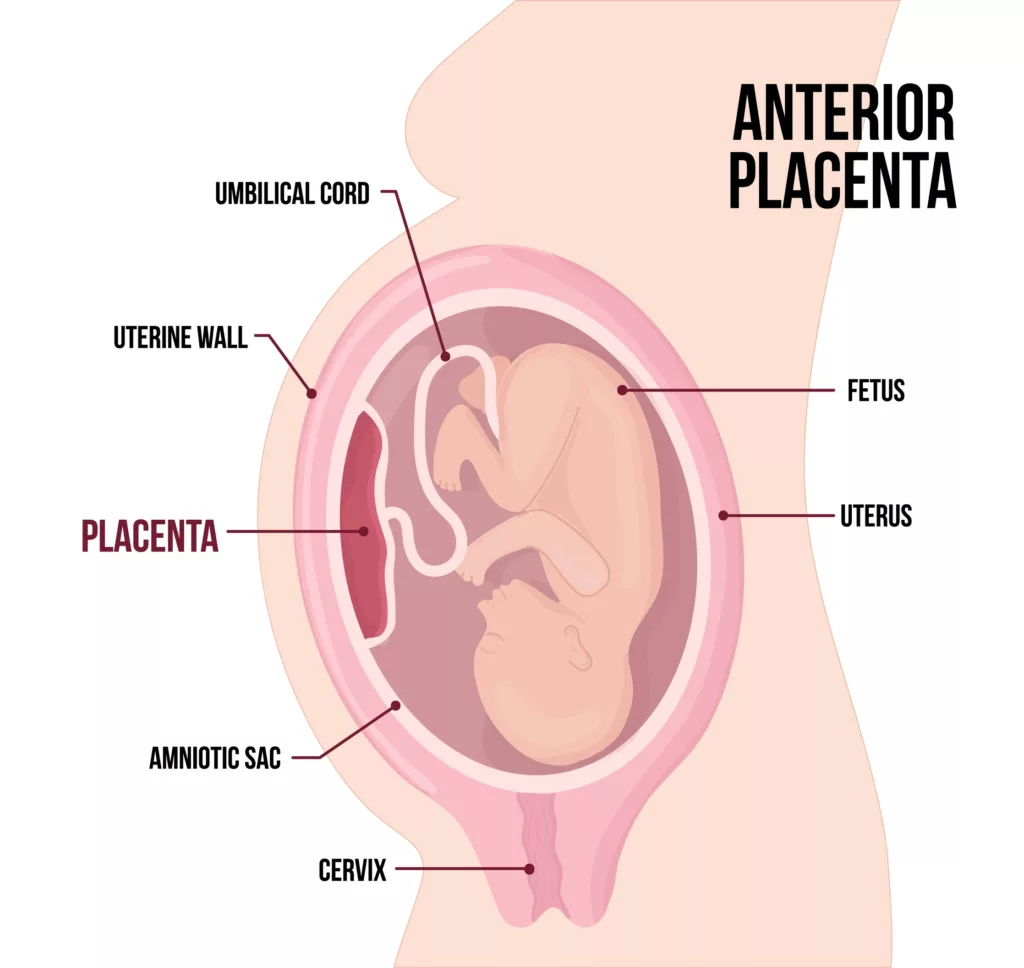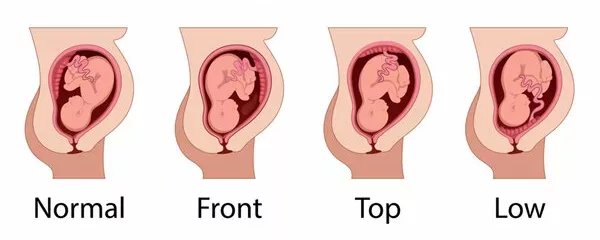The placenta presents itself at different positions in the uterus. The anterior Placenta is relatively common and is associated with lesser complications. We will discuss the anterior Placenta, its effect on your pregnancy, and the developing baby.
What is a Placenta?
The placenta is an organ that develops during pregnancy alongside the fetus. It serves several crucial functions in supporting the growing baby. First and foremost, it acts as a bridge between the mother and the developing fetus, facilitating the exchange of nutrients, oxygen, and waste products. The umbilical cord serves as a conduit between the developing fetus and the placenta. It contains blood vessels that transport oxygen and nutrients from the placenta to the fetus while simultaneously carrying waste products like carbon dioxide away from the fetus to the placenta for disposal. Additionally, it helps in regulating hormones that are necessary for the pregnancy to progress smoothly. After the baby is born, the placenta is typically expelled from the mother’s body, usually within a short time (Approximately 30 minutes) following childbirth.

What is an Anterior Placenta?
The Placenta is most commonly attached to the inner aspect of the fundus (top-most part) of the uterus. However, it may also present elsewhere within the organ.
Anterior Placenta refers to the condition wherein the organ is present in front of the developing fetus, i.e., it is attached to the inner aspect of the front wall of the uterus (the wall that faces your belly).
How Common is it?
The anterior placement of the Placenta is relatively common: it is present in approximately 50% of pregnancies1. Anterior Placenta: What it means, diagnosis & complications. Cleveland Clinic. (n.d.). Retrieved April 17, 2023, from https://my.clevelandclinic.org/health/diseases/23306-anterior-placenta#:~:text=How%20common%20is%20an%20anterior,to%2050%25%20of%20all%20pregnancies. and is usually not worrisome. Some studies suggest that mothers with blood group O and those who tend to sleep on their stomachs during conception2Magann, E. F., Roberts, W. E., McCurley, S., Washington, W., Chauhan, S. P., & Klausen, J. H. (2002). Dominant maternal sleep position influences the site of placental implantation. Military medicine, 167(1), 67-69. presents more with this placental placement. But the evidence isn’t conclusive yet.
Where else does the Placenta Attach?
Apart from the fundus and the anterior wall, the placental attachment can present as follows:

- Posterior: The Placenta can attach to the back wall of your uterus, the one along with your spine
- Fundal: The placenta can attach to the fundus (topmost part) of the uterus.
- Lateral: It can also attach to the sides of the uterine wall
- Low-Lying: Associated with complicated pregnancies, this placental presentation covers the cervical os (opening) either partially or completely (also known as placenta previa).
Benefits of Anterior Placenta
Pregnancies with an anterior placental presentation usually end with normal vaginal delivery. This rarely poses any ill effects on the developing fetus, if any. It is a soft cushion barrier between the developing baby and the abdomen.
Having an anterior placenta, which is positioned on the front wall of the uterus, can offer several benefits during pregnancy. Some of the advantages include:
- Cushioning Effect: The anterior placenta acts as a natural cushion between the baby and the mother’s abdominal wall. This can make fetal movements, such as kicks and punches, feel softer or less noticeable, providing a sense of comfort and reducing potential discomfort for the mother.
- Protection: The anterior placement of the placenta may offer additional protection for the baby. It can act as a barrier, shielding the baby from external pressure or impacts and providing an extra layer of safety.
- Sound Dampening: It can help dampen sounds from the outside, potentially reducing the intensity of noises that reach the baby. This can contribute to a more serene environment for the developing fetus.
- Visualization in Ultrasound: During ultrasound examinations, an anterior placenta can provide better visualization of the baby’s face as it is positioned closer to the ultrasound probe. This can offer clearer images for parents to see and cherish.
It’s important to note that while these benefits are often experienced by individuals with an anterior placenta, each pregnancy and placental positioning can vary. Consulting with a healthcare professional is essential for personalized and accurate information regarding an individual pregnancy.
Anterior Placenta Risks
It is common for the Placenta to attach to the front wall of your uterus.
Some factors associated with the condition are:
Baby Movements:
The anterior Placenta itself is not associated with any complications. However, as it cushions your baby from your abdomen, it may take a while for you to feel those tiny kicks and movements. The kicks may even feel softer than usual because of the barrier.
Fetal Heartbeat:
For the same reason, the sonologist might find it hard to detect the fetal heartbeat in the early stages of pregnancy if the Placenta is present anteriorly.
Amniocentesis:
The anterior Placenta can also be a hurdle in cases requiring amniocentesis. It is a diagnostic procedure wherein your sonologist draws a small amount of amniotic fluid from the amniotic cavity(membrane covering the fetus) to diagnose certain developmental abnormalities.
Back Labor:
With an anterior placenta, during labor, the odds of your baby presenting in the OP (occiput posterior) position, i.e., the back of your baby aligned against yours, are high3Gardberg, M., & Tuppurainen, M. (1994). Anterior placental location predisposes for occiput posterior presentation near term. Acta obstetricia et gynecologica Scandinavica, 73(2), 151-152.. This can produce increased pressure on your spine, causing prolonged labor and more pain in the back.
Will the Anterior Placenta Change My Belly Shape?
The placenta is a flexible and flat organ closely attached to the uterus wall. Therefore, it is unlikely for you or anyone to notice any changes in your belly shape. Your baby bump will appear regular even with an anteriorly lying placenta.
What is a Low-Lying Anterior Placenta?
An anterior low-lying placenta is when the Placenta is attached to the anterior uterine wall. However, the position is quite lower as compared to the normal. It means that the Placenta is present near your cervix.
The low-lying anterior Placenta is associated with pregnancy complications. It can cause mild to severe bleeding and may even lead to miscarriage.
Is Normal Delivery Possible with a Low-Lying Placenta?
Your gynecologist might give you a trial of normal vaginal delivery since this condition is not an absolute contraindication. However, if normal delivery does not proceed as smoothly as expected, she will probably rush you to OT for an emergency cesarean section.
How is an Anterior Placenta Diagnosed?
An ultrasound carried out between 18 to 21 weeks of pregnancy accurately diagnoses the position of the Placenta. This scan is also termed the ‘anomaly scan.’
With the expanding uterus, it is normal for the Placenta to change positions along the same wall. Hence, we can only detect it via ultrasound during the mentioned time frame.
Conclusion
In conclusion, the anterior Placenta is a fairly common condition with up to 50 percent incidence in all pregnancies. It is not associated with any risks or adverse outcomes, yet a low-lying anterior placenta may cause pregnancy complications.
The only trouble with an anteriorly-lying placenta would be a late sensation of fetal movements. It is normal for females with this presentation to not feel any baby kicks until 20 weeks of pregnancy since the kicks might also not be strong until then.
An ultrasound carried out between 18 to 21 weeks can diagnose the accurate position of your Placenta. Pregnancies usually deliver normally and are rarely associated with any complications.
Refrences
- 1. Anterior Placenta: What it means, diagnosis & complications. Cleveland Clinic. (n.d.). Retrieved April 17, 2023, from https://my.clevelandclinic.org/health/diseases/23306-anterior-placenta#:~:text=How%20common%20is%20an%20anterior,to%2050%25%20of%20all%20pregnancies.
- 2Magann, E. F., Roberts, W. E., McCurley, S., Washington, W., Chauhan, S. P., & Klausen, J. H. (2002). Dominant maternal sleep position influences the site of placental implantation. Military medicine, 167(1), 67-69.
- 3Gardberg, M., & Tuppurainen, M. (1994). Anterior placental location predisposes for occiput posterior presentation near term. Acta obstetricia et gynecologica Scandinavica, 73(2), 151-152.

